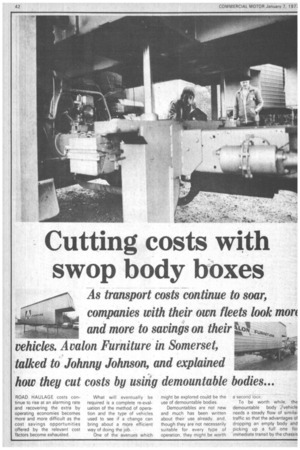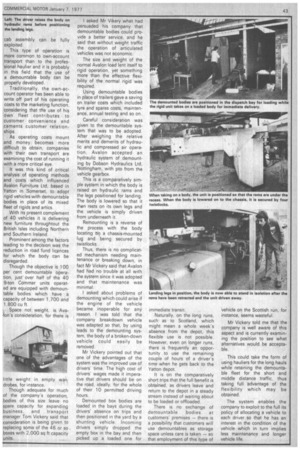Cutting costs with swop body boxes
Page 44

Page 45

If you've noticed an error in this article please click here to report it so we can fix it.
As transport costs continue to soar, companies with their own fleets look mon and more to savings on their V, vehicles. Avalon Furniture in Some talked to Johnny Johnson, and explained how they cut costs by using demountable bodies...
ROAD HAULAGE costs continue to rise at an alarming rate and recovering the extra by operating economies becomes more and more difficult as the cost savings opportunities offered by the relevant cost factors become exhausted. What will eventually be required is a complete re-evaluation of the method of operation and the type of vehicles used to see if a change can bring about a more efficient way of doing the job.
One of the avenues which might be explored could be the use of demountable bodies.
Demountables are not new and much has been written about their use already, and, though they are not necessarily suitable for every type of operation, they might be worth
a second io-oK To be worth whde, the demountable body :;'vehicle needs a steady flow of similar traffic so that the advantages of dropping an empty body and picking up a full one for immediate transit by the chassis cab assembly can be fully exploited.
This type of operation is more common to own-account transport than to the professional haulier and it is probably in this field that the use of a demountable body can be properly developed.
Traditionally, the own-account operator has been able to write off part of his operating costs to the marketing function, considering that the use of his own fleet contributes to customer convenience and cements customer relationships.
As operating costs mount and money becomes more difficult to obtain, companies with their own transport are examining the cost of running it with a more critical eye.
It was this kind of critical analysis of operating methods and costs which influenced Avalon Furniture Ltd, based in Yatton in Somerset, to adopt rigid vehicles with demountable bodies in place of its mixed fleet of rig ids and artics.
With its present complement of 40 vehicles it is delivering new furniture throughtout the British Isles including Northern and Southern Ireland.
Prominent among the factors leading to the decision was the reduction in road fund licences for which the body can be disregarded.
Though the objective is 100 per cent demountable operation, justover half of the 40 9-ton Commer units operated are equipped with demountable bodies which have a capacity of between 1,700 and 1,800 cu ft.
Space not weight, is Avalon's consideration, for there is little weight in empty wardrobes, for instance.
Though adequate for much of the company's operation, bodies of this size leave no spare capacity for expanding business, and transport manager Tom Vickery said that consideration is being given to replacing some of the 46 or so boxes with 2,000 sq ft capacity units. I asked Mr Vikery what had persuaded his company that demountable bodies could provide a better service, and he said that without weight traffic the operation of articulated vehicles was not economic.
The size and weight of the normal Avalon load lent itself to rigid operation, yet something more than the effective flexibility of the normal rigid was required.
Using demountable bodies in place of trailers gave a saving on trailer costs which included tyre and spares costs, maintenance, annual testing and so on.
Careful consideration was given to the demountable system that was to be adopted. After weighing the relative merits and demerits of hydraulic and compressed air operation, Avalon accepted an hydraulic system of demounting by Dobson Hydraulics Ltd, Nottingham, with pto from the vehicle gearbox.
This is a comparatively simple system in which the body is raised on hydraulic rams and the legs positioned for landing. The body is lowered so that it then rests on its own legs and the vehicle is simply driven from underneath it.
Remounting is a reverse of the process with the body locating 'On a chassis-mounted lug and being secured by twist locks.
Thus, there is no complicated mechanism needing maintenance or breaking down, in fact Mr Vickery said that Avalon had had no trouble at all with the system since it was adopted and that maintenance was minimal.
I asked about problems of demounting which could arise if the engine of the vehicle became inoperable for any reason. I was told that the company breakdown vehicle was adapted so that, by using leads to the demounting system, the body of a broken-down vehicle could easily be removed.
Mr Vickery pointed out that one of the advantages of the system was the improved use of drivers' time. The high cost of drivers' wages made it imperative that drivers should be on the road, ideally, for the whole of their 10 permitted driving hours.
Demounted box bodies are loaded in the bays during the drivers' absence on trips and then positioned in the yard by a shunting vehicle. Incoming drivers simply dropped the empty box in the bay and then picked up a loaded one for immediate transit.
Naturally, on the long runs, such as to Scotland, which might mean a whole week's absence from the depot, this flexible use is not possible. However, even on longer runs, there is frequently an opportunity to use the remaining couple of hours of a driver's time when he gets back to the Yatton depot.
It is on the comparatively short trips that the full benefit is obtained, as drivers leave and return to the depot in a steady stream instead of waiting about to be loaded or offloaded.
There is no exchange of demountable bodies at customers' premises -there is a possibility that customers will use demountables as storage space unless care is taken -so that employment of this type of vehicle on the Scottish run, for instance, seems wasteful.
Mr Vickery told me that the company is well aware of this aspect and is currently examining the position to see what alternatives would be acceptable.
This could take the form of using hauliers for the long hauls while retaining the demountable fleet for the short and middle distance traffic, thus taking full advantage of the flexibility which may be obtained.
The system enables the company to exploit to the full its policy of allocating a vehicle to each driver so that he has an interest in the condition of the vehicle which in turn implies less maintenance and longer vehicle life.




















































































